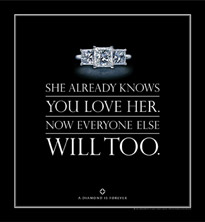Forever Diamonds
A powerful company, a catchy slogan, and how they forever changed the way we value diamonds.
By Barry B. Kaplan

A three-stone princess-cut
ring from the 2002/2003 DTC
Campaign. This advertisement
appeared on bus shelters,
buses, billboards, and other
prominent locations.
Japanese men were now
spending three to four months'
salary on their engagement
ring purchases, considerably
more than in the US
A new Japanese tradition
In the 1960s, De Beers aimed its marketing prowess at conquering international markets. Japan, Germany and
Brazil would be first, for which De Beers enlisted the help of J.Walter Thompson, an advertising agency with
a vast network of international subsidiaries and affiliates.
Japanese parents adhered to a 1500 year old tradition of arranging marriages for their children through
trusted go-betweens. In 1959, postwar Japan didn't permit the importation of diamonds, and the carbon-based
gemstone did not yet feature as part of the yuino-hin bundle of gifts exchanged between the parents of the
groom and the bride's family.
J. Walter Thompson's campaign sought to glamorize western values in a series of Japanese magazine advertisements
featuring European-styled women wearing diamond rings, and involved in a variety of outdoor sporting activities.
By 1981, sixty percent of married Japanese women sported a diamond. It had taken De Beers only fourteen years to
make Japan the second largest engagement ring market after the United States. Japanese men were now spending
three to four months' salary on their engagement ring purchases, considerably more than in the US.
Smaller is better
After extensive exploration in the late 50s, the Soviet Union had discovered several diamond mines in Siberia.
These mines unearthed a plethora of half carat or smaller diamonds at a frenzied pace. In a private agreement
with the Soviets, De Beers secured rights to this production. To sell the smaller stones, De Beers informed
N.W. Ayer to focus on a strategy stressing the importance of "quality, color and cut" over size. Pictures of
quarter carat rings immediately replaced pictures of larger rings. De Beers developed a new ring, called the
"eternity ring" which would feature as many as twenty-five diamonds. These rings would be targeted at older
women with the theme of "recaptured love".
By the mid 70s, the smaller-diamonds campaign was becoming too successful. Research showed that the average
size of diamonds had fallen from one carat in 1930 to .28 carats in 1976. Meanwhile, Soviet diamond output
continued to increase and De Beers sought additional avenues to market their production. They hoped to garner
the same success they had enjoyed in Japan with the new international campaigns in Brazil, Germany, Austria
and Italy. But that strategy, and existing sales of eternity rings would be insufficient to absorb all of
the Soviet's output.
Bigger is better
N.W. Ayer suggested a bilateral approach for their 1978 campaign - smaller diamonds displayed in photographs,
and an informative and emotive promotion aimed at reorienting consumer tastes and price preferences towards
solitaire rings and away from multi-stone jewelry. Furthermore, they would use strategic campaign refinements
to restore the status of bigger diamonds. Wholesale diamond sales reached $2.1 billion by 1979, a hundred-fold
increase since 1939. In 2002, sales reached $5.15 billion. The key to this enormous revenue growth was one
successful advertising campaign after another. But the collapse of the Soviet Union, civil unrest and war i
n Africa, and the discovery of new mines over the preceding decade had taken their toll on De Beers' command
of the diamond trade. By the turn of the millennium, De Beers' market share had dropped to sixty five percent.

